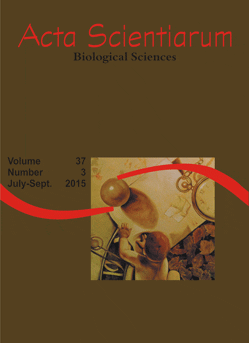<b>Morphoanatomy of <i>Serjania communis</i> Cambess. seedling (Sapindaceae)
Abstract
Serjania communis Cambess. (Sapindaceae) is a plant with climbing habit and occurs relatively often in Paraná State, Brazil. The fruits were collected at the 'Parque dos Pioneiros' a remnant of subtropical forest in Maringá, Paraná State, Brazil. The seedlings obtained in the greenhouse were described according to traditional techniques in plant morphology. Seedlings were embedded in historesin and sectioned in rotation microtome. The fruit is the samaroid type, the seeds have about 3 mm in length and brown color. Seedlings are epigeal phanerocotylar. The seedlings have a hairy hypocotyl, foliaceous cotyledons, reduced epicotyl, and two opposite eophylls. The root is diarch, the hypocotyl shows root-stem transition structure, stem epicotyl, and dorsiventral and hypostomatous cotyledons and eophylls. 'Tirodendros' with 45 days of age do not develop cambial variant.
Downloads
DECLARATION OF ORIGINALITY AND COPYRIGHTS
I Declare that current article is original and has not been submitted for publication, in part or in whole, to any other national or international journal.
The copyrights belong exclusively to the authors. Published content is licensed under Creative Commons Attribution 4.0 (CC BY 4.0) guidelines, which allows sharing (copy and distribution of the material in any medium or format) and adaptation (remix, transform, and build upon the material) for any purpose, even commercially, under the terms of attribution.
Read this link for further information on how to use CC BY 4.0 properly.












1.png)




3.png)













